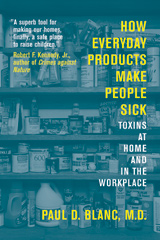
Paul D. Blanc
UCSF medical school Professor and Chief of the Division of Occupational and Environmental Medicine Paul D. Blanc, MD, reveals how commonplace products have poisoned significant sectors of the human population in his first book,
How Everyday Products Make People Sick: Toxins at Home and in the Workplace (University of California Press).
Through historical accounts up to the present day, Blanc unveils how seemingly harmless products - a tube of glue, a bottle of bleach, a rayon scarf, a brass knob, a wooden plank - have caused severe illness over the past three millennia and how governmental regulation has time and time again been insufficient.
"Every time I started to delve deeper into a subject, I found there was a rich story behind it," says Blanc. "In particular, I saw a reoccurring pattern where a novel technology would be introduced, and then a new illness would emerge. Although scientists would identify the connection, public health authorities did not sufficiently control the hazard."
An example of a repeated toxin in US manufacturing is carbon disulfide, which has proven to cause mental derangement and a myriad of other health problems. In the 19th century, the chemical was a byproduct of vulcanizing rubber. Although this technology was changed by the turn of the last century, rayon manufacturing began around the same time and led to the same diseases from the chemical once again. Blanc says carbon disulfide remains a particular problem in developing countries, where there is ongoing occupational exposure.
"Wearing rayon is not the problem. However, in manufacturing rayon, the chemical is released into the environment," says Blanc. "People make the false assumption that these chemicals only affect the manufacturers, but there is no magic barrier of what stops at the factory door and what's released on the other side."

Blanc addresses a full gamut of hazards, such as mercury poisoning, inhaling dust and fumes, water and air pollution, and asbestos, manganese and lead exposure. He also links gasoline fuel additives to Parkinson's disease. Infectious agents and emerging, chemically caused diseases are addressed, as well.
According to Blanc, examples of ongoing hazards for US consumers are specialty glues, cosmetic products, chemicals used with artificial nails and the misuse of chlorine bleach, which can lead to household release of chlorine gas.
This excerpt illustrates how Blanc references popular culture throughout the book to engage the reader while driving home his point regarding the dangers of chlorine bleach:
"We are all heirs to more than two millennia of a collective need to bleach everything in sight as white as driven snow. Once the airwaves carried a sing-songy commercial for a laundry detergent in which an irritating voice repeatedly recited, 'Ring around the collar, ring around the collar.' The commercial's darker echoes of 'Ring around the rosy,' originally a rhyme of the plague years, may have been unintended, but nonetheless it should give us all pause."
Rather than blowing the whistle on large corporations or industries, Blanc's goal is to increase overall awareness regarding the severity of the toxins in everyday products. Blanc hopes the book will inspire readers to work with environmental and labor groups and elected officials to put pressure on public health regulators, such as the Occupational Safety and Health Administration, the Food and Drug Administration, the Consumer Product Safety Commission and the Environmental Protection Agency, to adequately protect consumers from toxins.
"This book is a call to action for people to demand appropriate control of hazards by public health regulators," says Blanc. "I am a big believer that the problems exist at a societal level and that we have been failed by the existing regulatory apparatus."
Related Link:
To buy the book, go to
University of California Press



